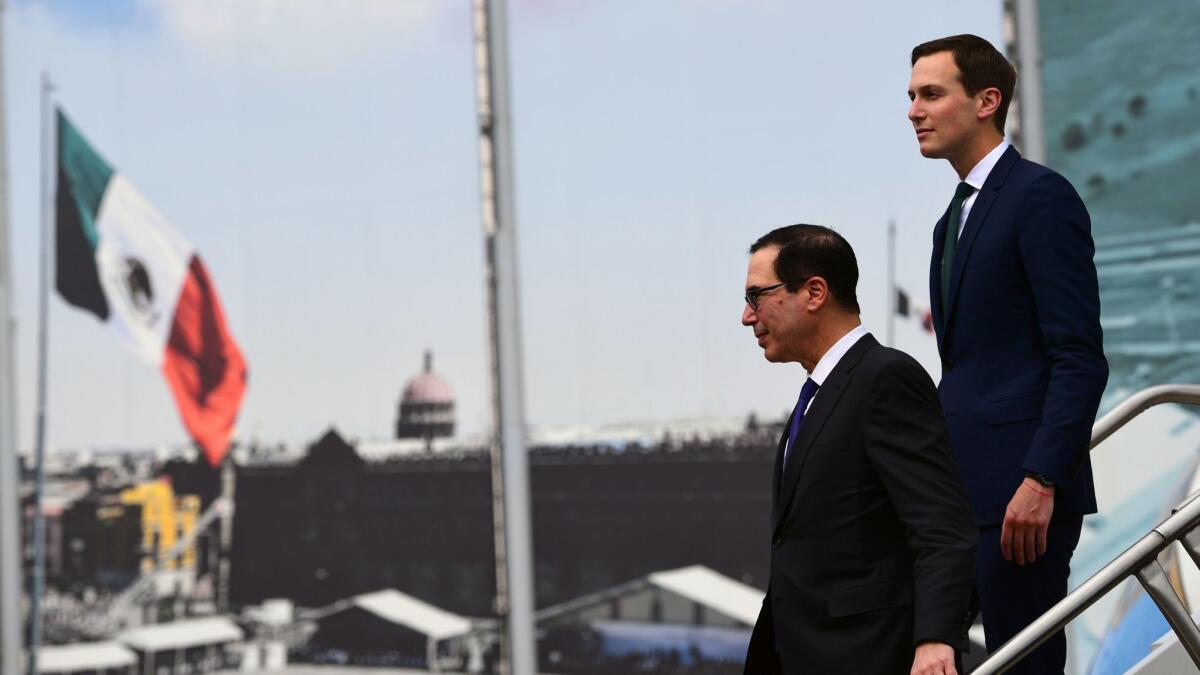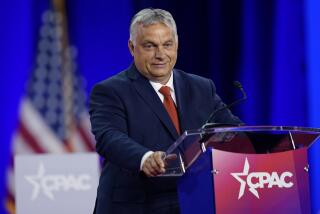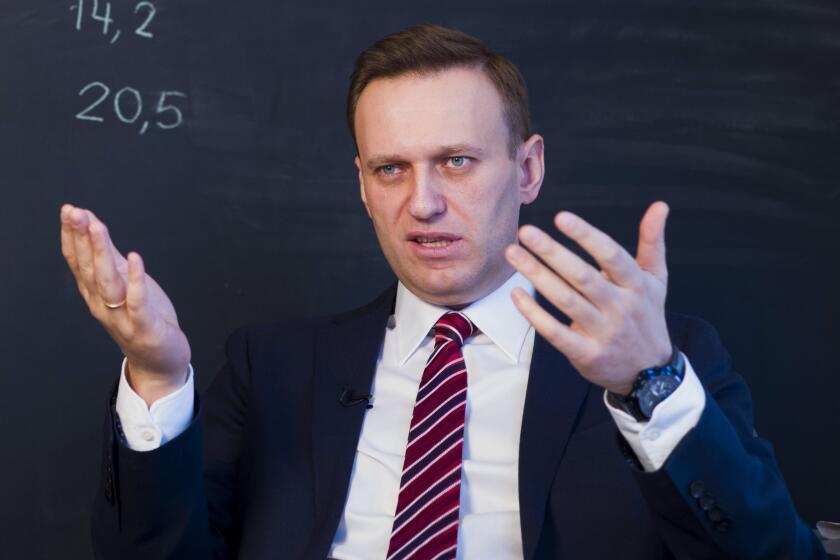Trump team meets Mexico’s incoming president in effort to repair relations

A team of top Trump administration officials traveled to Mexico City on Friday to meet the country’s next president and try to repair strained relations in a largely symbolic visit after nearly two years of diplomatic discord with America’s southern neighbor.
Secretary of State Michael R. Pompeo met with Mexico’s president-elect, Andres Manuel Lopez Obrador, a left-leaning populist who won the July 1 vote in a landslide. He met separately with outgoing President Enrique Peña Nieto, who has seen his popularity plummet in recent months in part for his failure to challenge President Trump more forcefully.
Pompeo was joined by Homeland Security Secretary Kirstjen M. Nielsen, Treasury Secretary Steven T. Mnuchin, and Jared Kushner, Trump’s son-in-law and senior advisor, who has Mexico in his portfolio of responsibilities. The delegation also included Carl Risch, head of consular affairs at the State Department, a sign of the priority on immigration.
Pompeo told Lopez Obrador that the presence of “four of our most senior people” showed that Trump was serious about improving ties with one of America’s closest allies after bitter clashes over immigration, border security, trade and other disputes.
“We wanted to come down here to let you know that President Trump cares deeply for the success of the relationship between our two countries, “ Pompeo said after greeting Lopez Obrador at his campaign headquarters in the trendy Roma neighborhood.
“Our presence here today signals that to you,” he added. “We know there have been bumps in the road between our two countries, but President Trump is determined to make the relationship between our peoples better and stronger.”
Dozens of demonstrators gathered outside the office, chanting, “Where are the children?” and waving signs. One read, in English, “I was deported. My crime? Being brown.”
Earlier, the U.S. delegation called on Peña Nieto in his office at Los Pinos, the presidential headquarters. In a statement later, his office said Peña Nieto asked for reunification “as soon as possible” of families separated by U.S. authorities at the border.
He also cited the July 4 assault on a 91-year-old man from Mexico who was beaten in the head with piece of concrete in Willowbrook. His attacker reportedly shouted for him to “go back to Mexico.” The Los Angeles County Sheriff’s Department later arrested a 30-year-old woman and charged her with assault with a deadly weapon.
Such incidents feed a climate of fear and racism, Peña Nieto said.
The daylong trip, which Pompeo undertook hours after returning to Washington from the NATO summit in Brussels and before he heads to Helsinki for Trump’s meeting Monday with Russian President Vladimir Putin, comes after months of rancor between Trump and Mexico.
Trump has referred to Mexicans as criminals, demanded Mexico pay for a border wall it doesn’t want and insulted Peña Nieto. The Mexican president canceled a planned trip to Washington in February after he and Trump tangled on the phone.
So far, Trump has been kinder to Lopez Obrador, including what both governments labeled a positive and cordial half-hour phone call after his election. Trump has pledged to work with the incoming Mexican leader after he takes office Dec. 1.
Peña Nieto was not eligible to run because the Mexican constitution prohibits reelection. The presidential candidate for his Institutional Revolutionary Party came in a distant third.
For all the initial rapprochement, Trump and Lopez Obrador almost certainly will clash on both substance and style.
“It’s a good start, but there are still a lot of issues that will be areas [of disagreement],” said Roberta Jacobson, who until May served as U.S. ambassador to Mexico. Trump “needs to stop vilifying Mexicans and blaming them for so many of the United States’ problems.”
Despite Trump’s claims, the Peña Nieto government has taken numerous steps to stem illegal immigration. With funding in part from the United States, Mexico has reinforced its southern border with Guatemala and deported nearly 150,000 Central Americans in the last year. But those policies are increasingly unpopular.
The Trump administration also has sought to persuade Mexico to accept the status of “safe third nation,” which would make it easier for Mexico to accept asylum applicants fleeing violence or persecution at home — and stop them from continuing north to the United States to seek refuge.
Mexico has long resisted the proposal. Although Mexico has accepted significantly more asylum applicants, it is reluctant to shoulder a burden likely to be many times greater. And human rights advocates oppose the plan because Mexico is hardly a safe country for immigrants and the vulnerable, who often are preyed on by human-trafficking networks and murderous drug gangs.
Whether Lopez Obrador will continue to pursue the U.S.-financed immigration policies is yet unknown. Many of his supporters see Mexico’s reinforcement of its borders as doing the U.S.’ dirty work.
Lopez Obrador has spoken frequently about tackling the root causes of poverty and insecurity that drive people northward in the first place, but he has yet to detail a plan for accomplishing those goals.
Another area of divergence will be foreign policy, where the Trump administration likely will lose a key partner.
Washington has relied on Mexico to take the lead in efforts to isolate Venezuela and urge its embattled socialist government to step down, in part to minimize an appearance of U.S. intervention in a region where American meddling is a sensitive issue.
Lopez Obrador, however, has pledged to return to Mexico’s tradition of keeping a low profile in international affairs.
Reflecting the domestic pressure, Mexico’s leading leftist newspaper La Jornada ran a column Friday warning the incoming president to be prepared to stand up to Trump’s team.
“More than a courtesy visit,” Soledad Loaeza wrote of the visitors, “this seems to be an intimidation tactic to warn the new president that he must do ... whatever they ask.”
For more on international affairs, follow @TracyKWilkinson on Twitter
UPDATES:
2:35 p.m.: This story was updated with additional details and a statement from President Enrique Peña Nieto.
12:50 p.m.: This story was updated with details from the meeting with Mexico’s incoming president.
This story was posted at 9:55 a.m.
More to Read
Start your day right
Sign up for Essential California for news, features and recommendations from the L.A. Times and beyond in your inbox six days a week.
You may occasionally receive promotional content from the Los Angeles Times.






